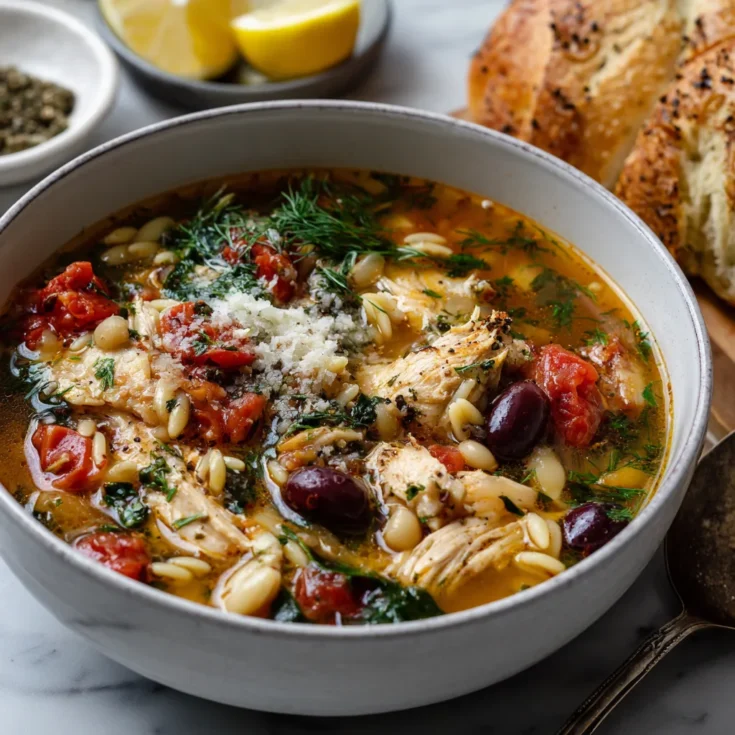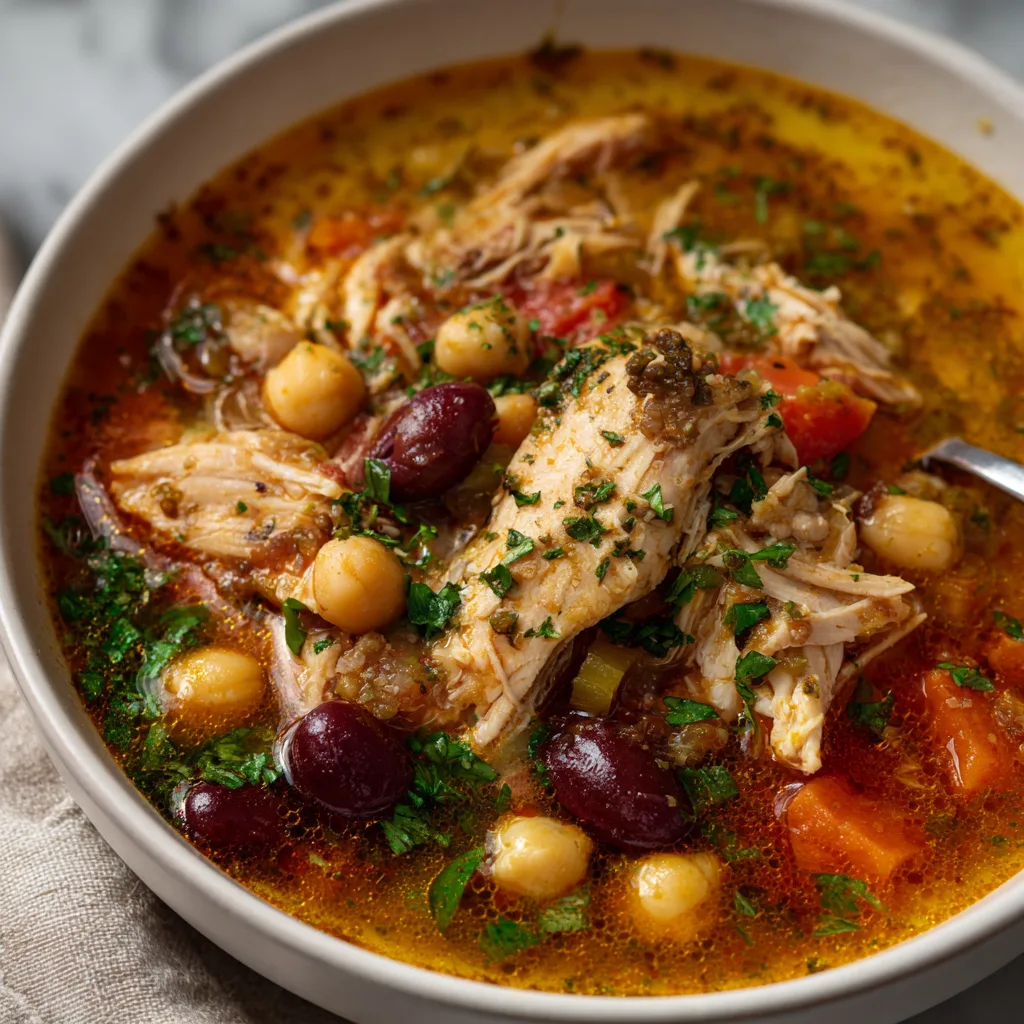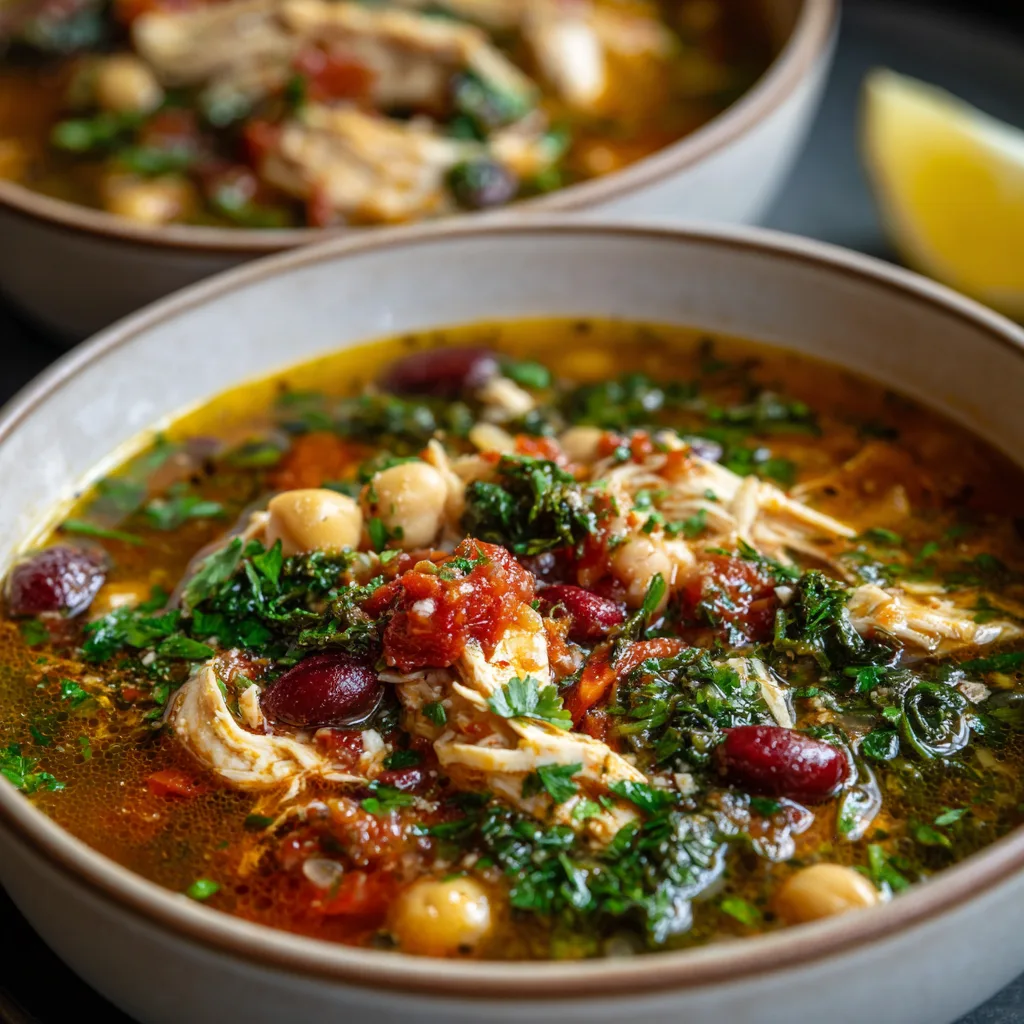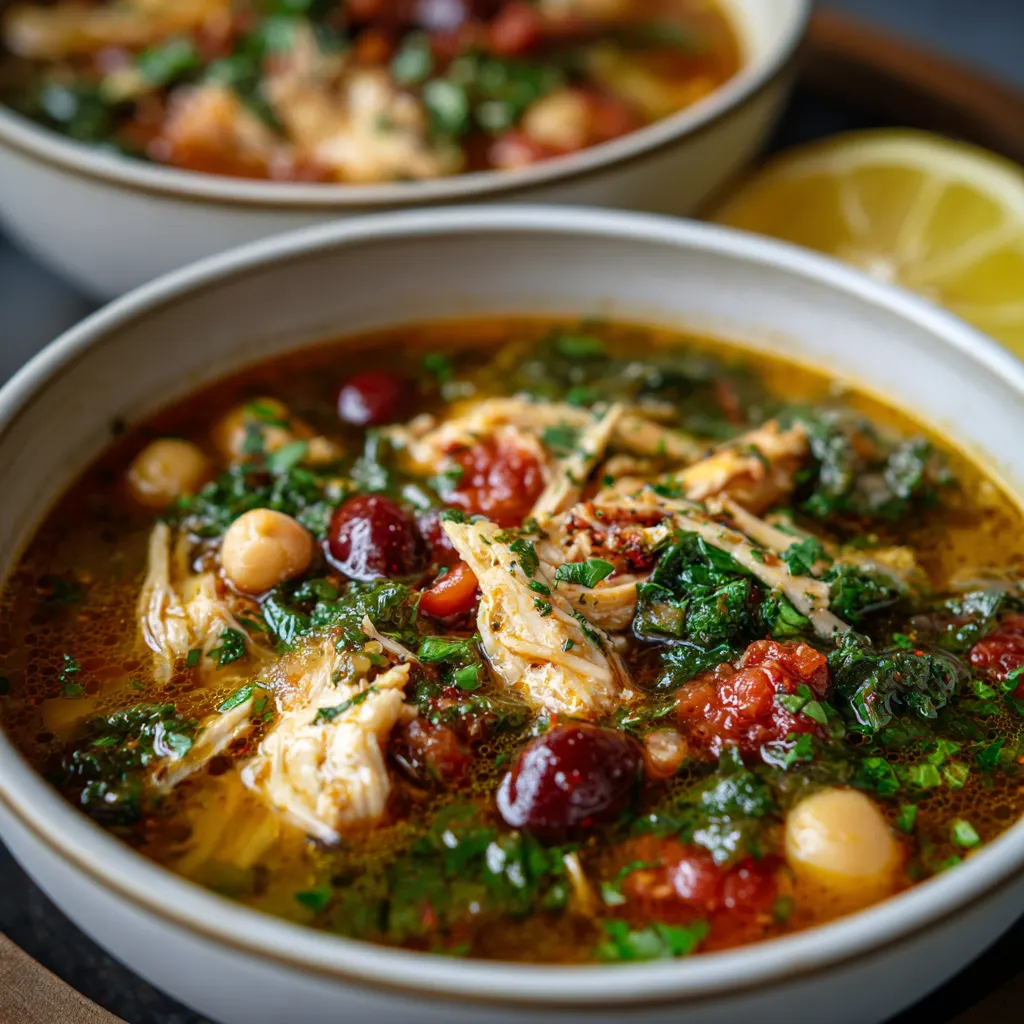Introduction to Mediterranean Chicken Soup
The Mediterranean diet stands out as one of the healthiest eating patterns worldwide. It emphasizes fresh ingredients, lean proteins, and heart-healthy fats. Vegetables, fruits, whole grains, nuts, and olive oil form its core. This diet promotes balance and variety, encouraging natural flavors over heavy processing. Chicken, a lean protein, plays a vital role, making dishes both satisfying and nutritious. The Mediterranean way of eating supports overall well-being and longevity.
In recent years, Mediterranean dishes have gained popularity worldwide. Their appeal lies not only in rich flavors but also in notable health benefits. Studies show that following this diet improves cardiovascular health and reduces inflammation. Its focus on wholesome ingredients helps maintain a healthy weight and supports the immune system. These factors explain why Mediterranean cuisine continues to attract attention from health enthusiasts and food lovers alike.
This article highlights Mediterranean chicken soup, a simple yet flavorful meal that embodies the principles of the Mediterranean diet. This soup combines fresh vegetables, aromatic herbs, and lean chicken to create a nourishing dish perfect for any season. Whether you seek comfort food or a healthful meal, this recipe delivers on both fronts. Read on to discover the origins, key ingredients, preparation tips, and a detailed recipe to make this Mediterranean favorite at home.
Historical Roots of Mediterranean Chicken Soup
The Mediterranean region has long been a crossroads of culture and cuisine, shaping diets that have lasted for centuries. Ancient civilizations such as the Greeks, Romans, and Phoenicians built their meals around fresh, local ingredients. Their dietary habits emphasized balance—combining grains, vegetables, olive oil, and lean proteins like chicken. These traditions laid the foundation for many dishes enjoyed today, including Mediterranean chicken soup. The emphasis on simplicity and natural flavors persists, making this soup a true reflection of ancient Mediterranean eating patterns.
Regional Variations of Mediterranean Chicken Soup
Mediterranean chicken soup takes many delicious forms across the region. In Greece, the classic Avgolemono features chicken broth thickened with egg and lemon, creating a silky texture and bright flavor. Meanwhile, Turkey offers Tavuk Çorbası, a hearty soup blending chicken with vegetables, rice, and herbs. Each country brings its unique touch by adding local spices and ingredients. These variations highlight the diversity within Mediterranean cuisine while keeping the nourishing essence of chicken soup intact.
Cultural Importance of Chicken Soup in the Mediterranean
Chicken soup holds a special place in Mediterranean culture beyond its taste. Families often gather around bowls of homemade soup during celebrations or as comfort during illness. Traditionally, this soup symbolizes warmth, healing, and care. Many Mediterranean households pass down chicken soup recipes through generations, making it a staple for both everyday meals and festive occasions. The soup’s healing reputation stems from its nutrient-rich ingredients, believed to support recovery and boost strength. It remains a cherished dish that connects people to their heritage and each other.
Essential Ingredients in Mediterranean Chicken Soup
Mediterranean chicken soup relies on a few key ingredients that create its distinctive flavor and nutritional value. The primary protein source typically comes from lean chicken, such as boneless, skinless breasts or thighs. These cuts provide a tender texture while keeping the soup light and healthy. Choosing lean chicken helps maintain a balanced meal, packed with high-quality protein necessary for muscle repair and immune support.
Fresh vegetables form the heart of this soup, contributing color, flavor, and nutrients. Common choices include carrots, celery, onions, and tomatoes. These vegetables create a rich, aromatic base that complements the chicken and adds depth to the broth. Their natural sweetness balances the savory herbs and spices, making the soup both satisfying and wholesome.
The soup’s vibrant flavor also comes from a blend of Mediterranean herbs and spices. Classic seasonings like oregano, thyme, and bay leaves infuse the broth with warmth and earthiness. Aromatics such as garlic and freshly ground black pepper enhance the savory profile and provide subtle layers of complexity. These herbs and spices not only add taste but also offer health benefits, supporting digestion and inflammation control.
Another important component is the use of healthy fats, primarily from extra virgin olive oil. This oil adds richness and a smooth mouthfeel while contributing heart-healthy monounsaturated fats. Olive oil’s antioxidants boost the soup’s nutritional profile and support overall wellness.
For added texture and nutrition, some recipes include whole grains or legumes, such as orzo, rice, or chickpeas. These ingredients enhance the soup’s body, making it more filling and balanced. They also provide fiber, which supports digestive health and helps regulate blood sugar levels.
Nutritional Benefits of Mediterranean Chicken Soup
This soup offers several nutritional advantages, starting with its high protein content from the chicken. Protein plays a vital role in repairing muscles, producing enzymes, and supporting immune defenses. Including adequate protein in meals helps maintain energy and promotes satiety.
The fresh vegetables supply a variety of vitamins and minerals, especially vitamins A, C, and K. Carrots provide beta-carotene, a precursor to vitamin A, essential for vision and skin health. Tomatoes and celery offer vitamin C, which supports immunity, while leafy herbs contribute vitamin K for bone health. Additionally, minerals like potassium and magnesium found in the vegetables help regulate blood pressure and muscle function.
Furthermore, Mediterranean chicken soup contains ingredients rich in antioxidant properties. Garlic and olive oil contain compounds that fight oxidative stress, reducing inflammation and promoting cardiovascular health. These antioxidants help protect cells from damage and support long-term wellness.
Altogether, the combination of lean protein, fresh vegetables, herbs, healthy fats, and optional grains makes Mediterranean chicken soup a nutrient-dense, flavorful, and balanced meal choice.
Traditional Cooking Methods for Mediterranean Chicken Soup
Simmering for Flavor Extraction
Simmering stands at the core of creating a rich and flavorful Mediterranean chicken soup. The process begins by gently cooking lean chicken pieces alongside fresh vegetables like carrots, celery, and onions. Simmering over low heat allows the ingredients to slowly release their natural flavors into the broth. This slow cooking method not only deepens the soup’s taste but also helps extract valuable nutrients from the chicken and vegetables. Keeping the temperature just below boiling ensures the broth remains clear and the chicken tender. This gentle heat preserves the integrity of herbs and spices, allowing their aromas to infuse without becoming overpowering.
Use of Broth vs. Water
Choosing the right cooking liquid significantly affects the soup’s depth and richness. Using homemade or store-bought chicken broth offers a fuller, more robust flavor compared to plain water. Broth adds layers of savory taste derived from simmered chicken bones, herbs, and vegetables. It also boosts the soup’s nutritional value by incorporating minerals and gelatin from the bones. When broth isn’t available, water can suffice, but adding extra herbs or seasoning may be necessary to compensate for the missing flavor. Preparing the soup with broth elevates the overall experience, making every spoonful more satisfying.
Incorporation of Whole Grains or Legumes
Adding whole grains such as orzo or rice, or legumes like chickpeas, transforms the soup into a hearty, more filling meal. These ingredients contribute texture and subtle flavor variations while increasing fiber and protein content. Including grains or legumes creates a well-rounded dish that satisfies hunger for longer periods. To maintain ideal texture, cook grains or legumes separately or add them in the last 15–20 minutes of simmering. This approach prevents overcooking and mushiness, ensuring each bite remains enjoyable.
Modern Variations and Adaptations of Mediterranean Chicken Soup
Slow Cooker and Instant Pot Recipes
For convenience, many home cooks turn to slow cookers or Instant Pots to prepare Mediterranean chicken soup. These appliances simplify the cooking process by allowing ingredients to meld over several hours or under pressure in a fraction of the time. Using a slow cooker lets flavors develop gradually without constant supervision, while the Instant Pot offers a quick yet flavorful alternative. Both methods preserve the soup’s nutritional integrity and tenderize the chicken effectively. They suit busy lifestyles without compromising on taste or health benefits.
Vegetarian and Gluten-Free Options
While traditional Mediterranean chicken soup centers on chicken, it can be adapted to fit vegetarian or gluten-free diets. Replacing chicken with tofu or chickpeas provides plant-based protein and keeps the soup hearty. For gluten-free versions, substitute orzo with gluten-free grains like quinoa or brown rice. Adjust cooking times accordingly to accommodate different ingredients. These alternatives maintain the essence of Mediterranean flavors while catering to dietary needs.
Flavor Enhancements for Brightness and Depth
To elevate the soup’s flavor, adding a splash of lemon juice, fresh herbs such as parsley or dill, or a touch of vinegar brightens the dish. These elements introduce freshness and a slight tang, balancing the savory richness of the broth. Adding lemon juice just before serving keeps its vibrant flavor intact. Fresh herbs can be stirred in during the final minutes of cooking or used as a garnish. These simple enhancements refresh the palate and add complexity to every spoonful.
Ideal Pairings for Mediterranean Chicken Soup
Bread: The Perfect Accompaniment
Serving Mediterranean chicken soup alongside crusty whole-grain bread or warm pita adds a traditional and satisfying element to the meal. The bread’s hearty texture complements the soup’s smooth broth, offering a pleasant contrast. Whole-grain options provide extra fiber and nutrients, making the meal more wholesome. Pita bread, soft and versatile, allows for dipping and soaking up the flavorful broth. Both choices elevate the dining experience, making the meal feel complete and comforting.
Salads to Balance the Meal
Pairing the soup with a fresh salad enhances both nutrition and flavor variety. A Greek salad, loaded with cucumbers, tomatoes, olives, and feta cheese, adds crispness and tangy notes that brighten the palate. Alternatively, tabbouleh, a refreshing mix of parsley, mint, bulgur wheat, and lemon juice, offers a vibrant texture and herbaceous flavor. These salads bring balance by introducing raw, fresh ingredients that complement the warmth and heartiness of the soup.
Beverages to Complement Flavors
To round out the meal, choose beverages that harmonize with Mediterranean flavors without overpowering them. Herbal teas, such as chamomile, mint, or lemon verbena, provide soothing, mild flavors that enhance digestion and refresh the palate. These teas work well with the soup’s herbs and spices, creating a cohesive dining experience. Avoid strong or heavy drinks that might clash with the subtle complexity of the dish.
Presentation Tips for Mediterranean Chicken Soup
Garnishing for Color and Freshness
A simple garnish can transform the look and taste of your soup. Adding fresh herbs like parsley or dill right before serving injects vibrant color and a burst of fresh aroma. These herbs complement the soup’s flavors and provide a visually appealing contrast to the golden broth. Sprinkle chopped herbs generously for an inviting presentation.
Serving Temperature and Warmth
Serving the soup at the right temperature ensures maximum enjoyment. The soup tastes best when hot but not boiling, around 140–160°F (60–70°C). To keep it warm before serving, use a slow cooker on the “keep warm” setting or cover the pot tightly to retain heat. If reheating, warm gently on the stovetop to preserve texture and flavor. Serving the soup at an ideal temperature maintains its comforting qualities and allows the flavors to shine fully.
FAQs about Mediterranean Chicken Soup
What makes Mediterranean chicken soup different from other chicken soups?
Mediterranean chicken soup features olive oil, fresh herbs, and vegetables, focusing on heart-healthy fats and fresh, wholesome produce.
Can I make this soup ahead of time?
Yes. You can prepare the soup in advance, refrigerate for up to 3 days, or freeze it for up to 3 months.
Is this soup suitable for special diets?
Absolutely. You can adapt the recipe to be gluten-free or dairy-free by using suitable substitutes.
What are some variations of Mediterranean chicken soup?
Try adding legumes like chickpeas, swapping grains for quinoa, or including leafy greens such as spinach for added nutrition and flavor.
For Two Mediterranean Chicken Soup Recipe – Healthy & Flavorful Dinner

This hearty and flavorful soup combines lean chicken, fresh vegetables, and Mediterranean herbs. It’s a nourishing meal perfect for any dinner occasion.
Ingredients
- 1 lb boneless, skinless chicken breasts
- 1 tablespoon extra virgin olive oil
- 1 onion, chopped
- 2 carrots, sliced
- 2 celery stalks, chopped
- 2 cloves garlic, minced
- 1 can (14.5 oz) diced tomatoes
- 4 cups chicken broth
- 1 teaspoon dried oregano
- Salt and pepper to taste
- Optional: 1 cup cooked orzo or rice
Instructions
Notes




